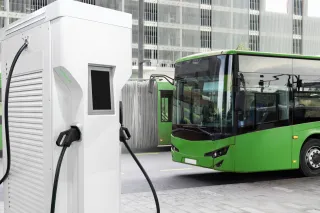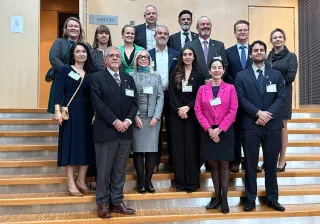New 4C batteries and megawatt-level charging will revolutionise electric transport. Charging times will be considerably shortened, which will increase the competitiveness of electric vehicles—even heavy-duty vehicles. For this reason, the planning of a megawatt-level pilot charging corridor for main road 4 must now begin.
In August 2023, the world’s largest battery manufacturer, CATL from China, launched a new 4C LFP battery that charges in 15 minutes. The battery production will begin this year. Another Chinese battery manufacturer, CALB, supplies similar 4C batteries for the Chinese Xpeng G9 electric car. At the same time, megawatt-level charging, that is, MCS charging is developing rapidly: the industry standard will be completed by 2025, and the corresponding products will enter the market as early as 2024.
Passenger cars will travel faster
4C batteries can reduce the charging time of passenger cars to less than 10 minutes—even at existing charging stations. For example, for an 80-kWh battery, the maximum charging power with 4C would be approximately 320 kW. Charging stations capable of this have been built in Finland for a long time, and many stations have the capabilities for maximum power of up to 400 kW. Xpeng G9, which is also sold in Europe, uses 800V high-voltage platform-based 4C cells and promises 400 kW maximum charging power.
- 80 kWh battery and 4C battery cell
- Charging time 10 minutes
- Driving range from the charge approximately 300 km
Reducing charging times speeds up travel and increases the service capacity of charging stations. The 10-minute charging time is close to the fuelling time of an internal combustion engine vehicle, and charging does not make travel significantly slower any more—in terms of driving safety, it is also a good idea to rest for 10 minutes after driving 300–400 km. Above all, fast charging makes it easier to electrify professional vehicles such as taxis.
Battery semi-trucks will become even more competitive
What does MCS charging and 4C batteries mean for heavy-duty vehicles? VTT has already calculated that with MCS charging, 1 MW charging power and approximately 700 kWh battery a semi-truck can be driven for 4.5 hours with a 45-minute charging. For long-distance transports, the driver can charge the battery during the statutory rest period without waiting for charging separately.
In MCS charging, the maximum power is planned to be 3.7 MW. A charging space with more power would serve three cars in the same time as a 1-MW charging space would serve one. The driver could also schedule their breaks more freely—to charge their car somewhere and take a longer break elsewhere. Fast charging is also needed in extremely high utilisation rate applications. A good example is the implementation of internal transport between Danfoss sites in Denmark. Charging power should be proportional to the duration of the break: On a 45-minute break, it is not beneficial to charge at more than 1 MW, and approximately 100 kW is enough when charging overnight.
As technology develops, a battery-powered semi-tractor can match a hydrogen fuel cell semi-truck or even best it both in terms of driving range and fuelling speed. Although the diesel semi-truck still beats both, the difference in fuelling times has narrowed rapidly.
- battery size 700 kWh (for example, Iveco)
- charging current 4C
- maximum charging power 2.8 MW
- charging time approx. 12 minutes
- driving range approx. 400 km
- 32 kg hydrogen tank
- 350 bar pressure
- fuelling time 8–20 minutes
- driving range 400 km
Easier electrification of long-distance buses
New technology also has a strong impact on long-distance bus transport. Long-distance buses stop briefly at stations, which has made it difficult to implement a fully electric long-distance bus. 4C batteries and a 10-minute charging time changes this—a fully electric long-distance bus can keep the same schedule as a diesel bus.
For example, Onnibus stops on its M4 Helsinki-Rovaniemi route for 20 minutes in Jyväskylä and for 15 minutes in Oulu. The longest leg is 370 km long. For example, if the bus was to consume 1.5 kWh/km, it should have a battery of at least 700 kWh to allow the leg to be driven safely under all conditions. Such a model is already on the market: Van Hool TDX25E. If this bus was upgraded with a 4C battery, it would also be suitable for long routes in Finland.
It would be an exciting idea to get an MCS charging corridor for electric buses, for example, on the Flixbus Vaasa–Warsaw route. The MCS charging infrastructure should not only be designed for semi-trucks, but also for long-distance buses.
Challenges are transferred to electric infrastructure
Regarding vehicles, we are very close to taking the next step in performance by upgrading batteries to charge faster. However, increasing charging power bring new challenges, such as heat management. The waste heat generated during charging must be effectively conducted from the battery to avoid the need to limit charging power due to the heating of the battery.
However, the bigger challenges concern the power grid and charging infrastructure. In the future, semi-truck parks and resting areas will need very robust electricity connections, as will urban travel centres. For example, a resting area offering fast MCS charging for 10 semi-trucks would require at times up to 30 MW of electrical power! We must prepare for this already: the technological transformation happens surprisingly suddenly, but the construction of infrastructure may take years, for example, due to the delivery times of high-voltage electricity connections.
Who would invest in the pilot charging corridor?
Market demand for flexible, energy-buffering and scalable MW-level charging solutions is emerging already in a couple of years, and we must enter this competition in time. If Finland had a pilot charging corridor for testing MCS charging with semi-trucks and buses, solutions could be developed and scaled in a genuine environment.
The EU AFIR regulation contains requirements for the electrification of the European TEN-T road network. For this reason, it is a good idea to already start planning the MCS charging corridor for main road 4. This requires close cooperation between authorities and different companies, from charging service providers to electricity and power grid companies and resting area entrepreneurs. Above all, we need someone to take the initiative. At the same time, we must ensure that charging infrastructure subsidies for electric vehicles are not cut.
If main road 4 would have MCS charging stations for heavy-duty vehicles initially, for example, in Jyväskylä, Hirvaskangas and Oulu, it would cost approximately 3–5 million euros. This way, semi-trucks from Helsinki to Tornio or buses from Helsinki to Rovaniemi could be driven with battery power. Who will be the first to take action?







